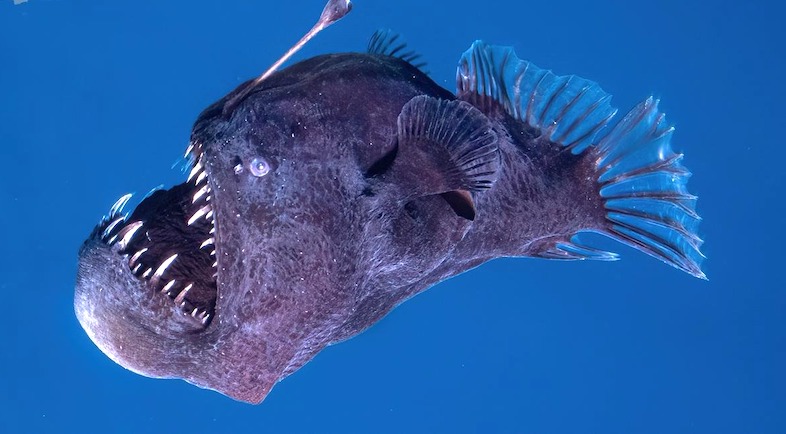In late January 2024, a rare and impressive video began circulating on the internet, showing a “black devil” fish (Melanocetus johnsonii) swimming close to the ocean’s surface during the day. The footage was taken approximately two kilometers off the coast of Tenerife, Spain, and quickly caught the attention of the scientific community.
This recording was considered historic by experts, as this fish typically inhabits the ocean’s depths, between 200 and 2,000 meters below the surface. The appearance of this creature in shallow, sunlit waters is highly unusual and raises various questions about what might have caused it to emerge from such a hostile and isolated environment.
The NGO Condrik Tenerife, dedicated to the research and preservation of sharks and rays in the Canary Islands, was responsible for releasing the footage and collecting the specimen for study. Scientists are now investigating the potential reasons behind this phenomenon, which could be related to environmental changes, disruptions in the animal’s habitat, or even health issues that forced it to leave the depths.

But what makes this fish so fascinating? And what hypotheses might explain its presence at the surface?
The black devil is one of the most enigmatic and terrifying fish of the deep sea. Its intimidating appearance is the result of a combination of anatomical factors: a dark, rounded body, a mouth filled with long, sharp teeth, and a bioluminescent appendage on its head, which acts as a lure to attract its prey.
This glowing structure, known as the esca, is a result of a symbiotic relationship with bioluminescent bacteria, which emit a bluish-green light in the dark depths of the ocean. This mechanism is essential for the species’ survival, as the black devil inhabits an area where sunlight does not reach, making bioluminescence an evolutionary advantage for capturing unsuspecting prey.
Additionally, this species exhibits extreme sexual dimorphism, meaning that males and females show significant differences. While females can grow up to 20 centimeters in length, males are much smaller, only a few centimeters long. In adulthood, the male becomes completely dependent on the female, merging its body with hers in a process known as sexual parasitism. It loses its internal organs and lives solely to fertilize the female’s eggs.
The fish’s scientific name, Melanocetus johnsonii, comes from Greek and literally means “black sea monster,” a fitting description of its appearance and predatory behavior. This species is found in tropical and subtropical seas worldwide, but it is rarely seen alive due to its preference for extremely deep, inaccessible environments.
The appearance of an abyssal fish in shallow waters is an extremely rare phenomenon, but not unprecedented. Similar cases have been recorded in other parts of the world, typically involving deep-sea fish that, for some reason, lost the ability to return to their natural habitat.
The NGO Condrik Tenerife, responsible for studying the animal found, raised some possible explanations for this unusual behavior:
Disease or Serious Injury
One of the most likely hypotheses is that the fish was sick, injured, or weakened, which may have affected its ability to regulate the depth at which it lives. As with other deep-sea fish, an issue with the swim bladder or other organs could have caused it to lose control of its buoyancy, inadvertently rising to the surface.
Escape from a Predator
Another possibility is that the black devil was being pursued by a predator and, in an attempt to escape, ended up emerging beyond its comfort zone. While it is a formidable predator in its natural environment, it can also fall prey to sharks and other large abyssal fish that share the ocean’s depths.
Anomalous Ocean Currents
The ocean’s depths are influenced by strong underwater currents, which can move marine organisms into areas where they would not normally be found. An upwelling current could have carried the black devil to shallower layers, preventing its return.
Environmental Changes
Global climate changes and shifts in ocean balance may be causing impacts on the behavior of various marine species. Rising ocean temperatures and reduced oxygen levels in certain areas could force abyssal animals to search for new environments, even if it means venturing into waters that are unsuitable for their survival.
Regardless of the cause, the presence of this fish at the surface is an extremely rare event and offers scientists a valuable opportunity to study the species more closely.
After being found, the black devil was carefully analyzed by researchers, who quickly realized that the fish would not survive at the surface. Abyssal fish are adapted to live under extremely high pressures and freezing temperatures, and sudden changes in these factors can be fatal to them.
Given this situation, the specimen was collected and transported to the Museum of Nature and Archaeology (MUNA) in Santa Cruz de Tenerife. There, scientists are conducting detailed studies to better understand the animal’s condition, its physiology, and the possible reasons for its unexpected ascent.
This study could help uncover not only aspects of the black devil’s biology but also oceanographic phenomena that might be influencing marine life at great depths. The event underscores the importance of ocean exploration, as many of its species and ecosystems remain largely unknown.
The appearance of the black devil fish at the surface is a reminder that the deep ocean still holds countless mysteries. Despite scientific advances, many species that inhabit this region are difficult to study, and encounters like this provide a unique opportunity to expand our knowledge of the secrets of the abyssal waters.
The presence of this bioluminescent predator in an environment where it should not be raises questions not only about its biology but also about changes that may be occurring in marine ecosystems.Are we merely witnessing an isolated phenomenon? Or could this be a sign of larger transformations occurring in the oceans? Time and science will help us find these answers.

